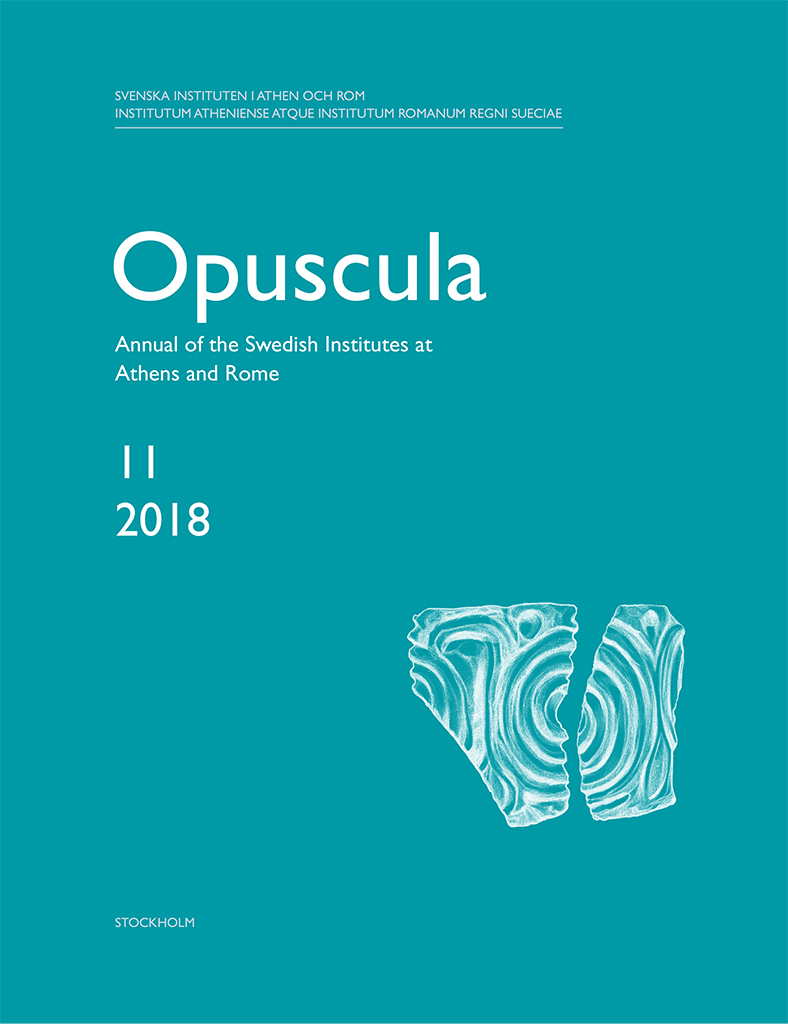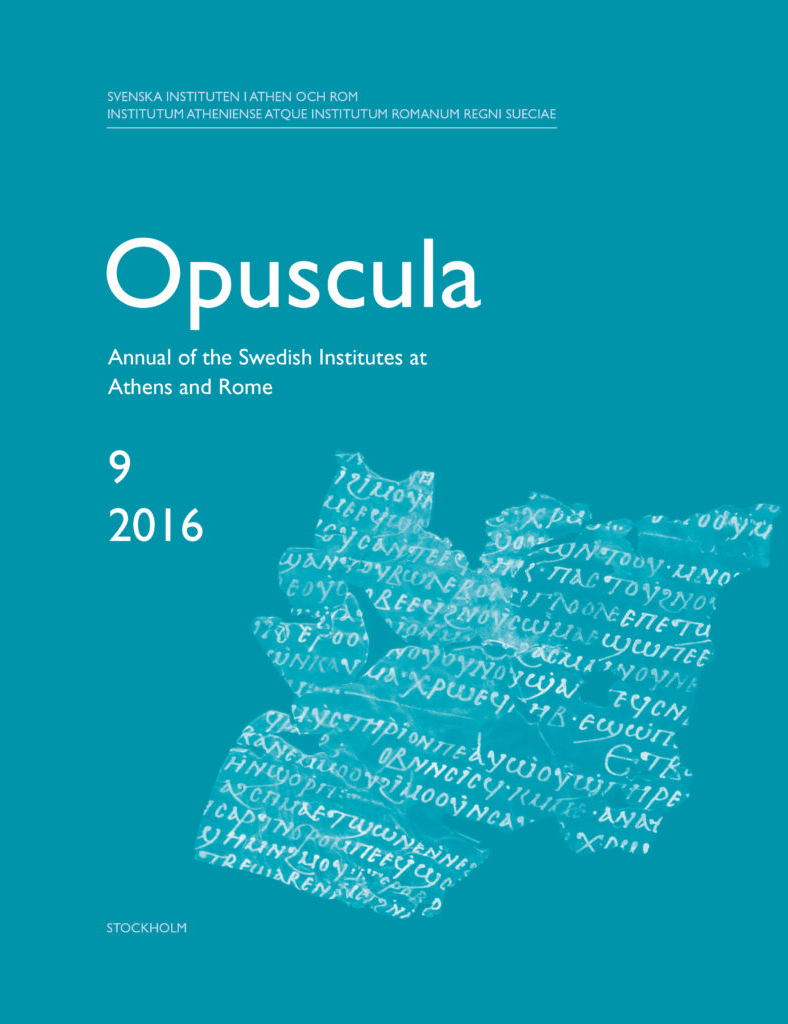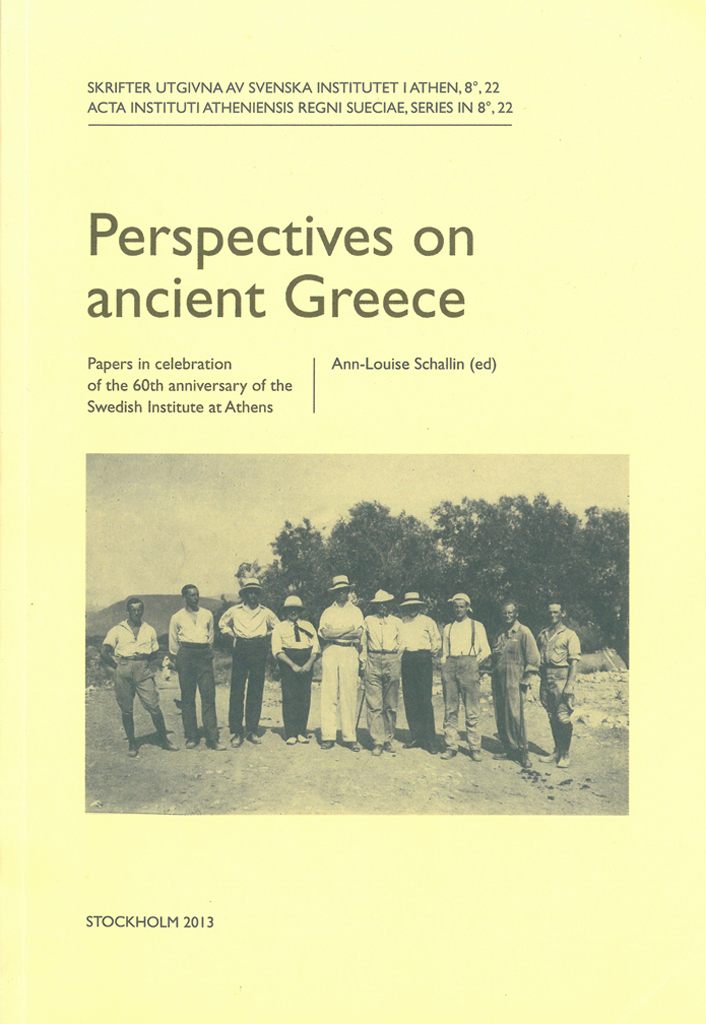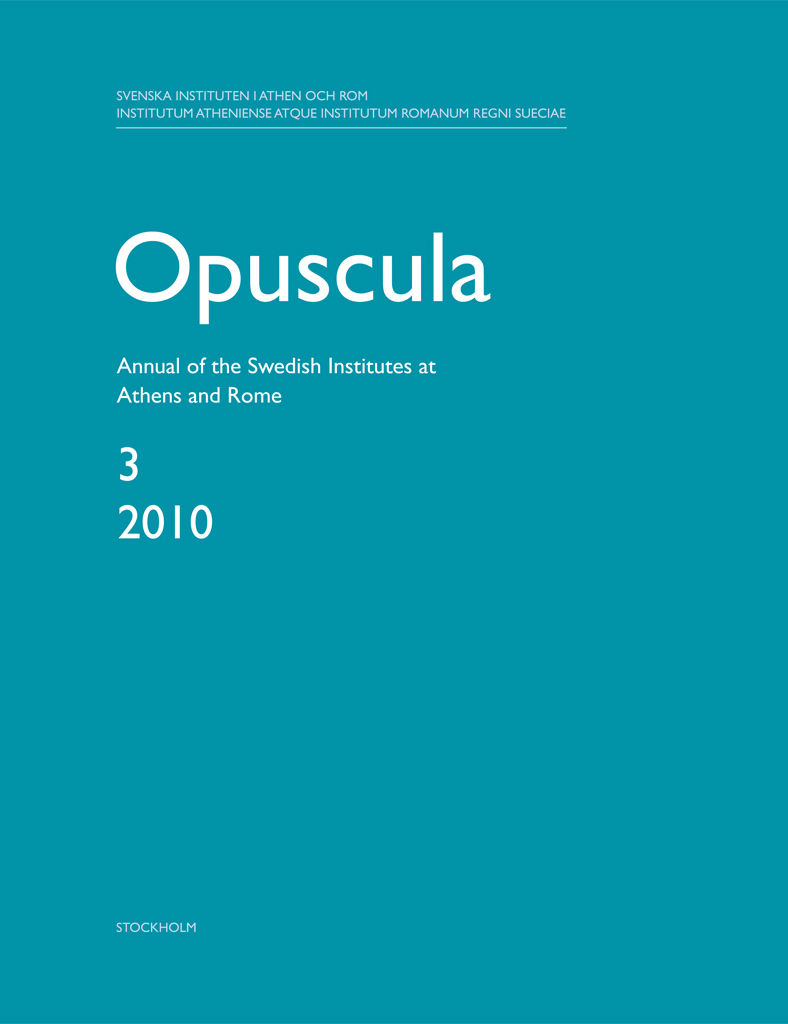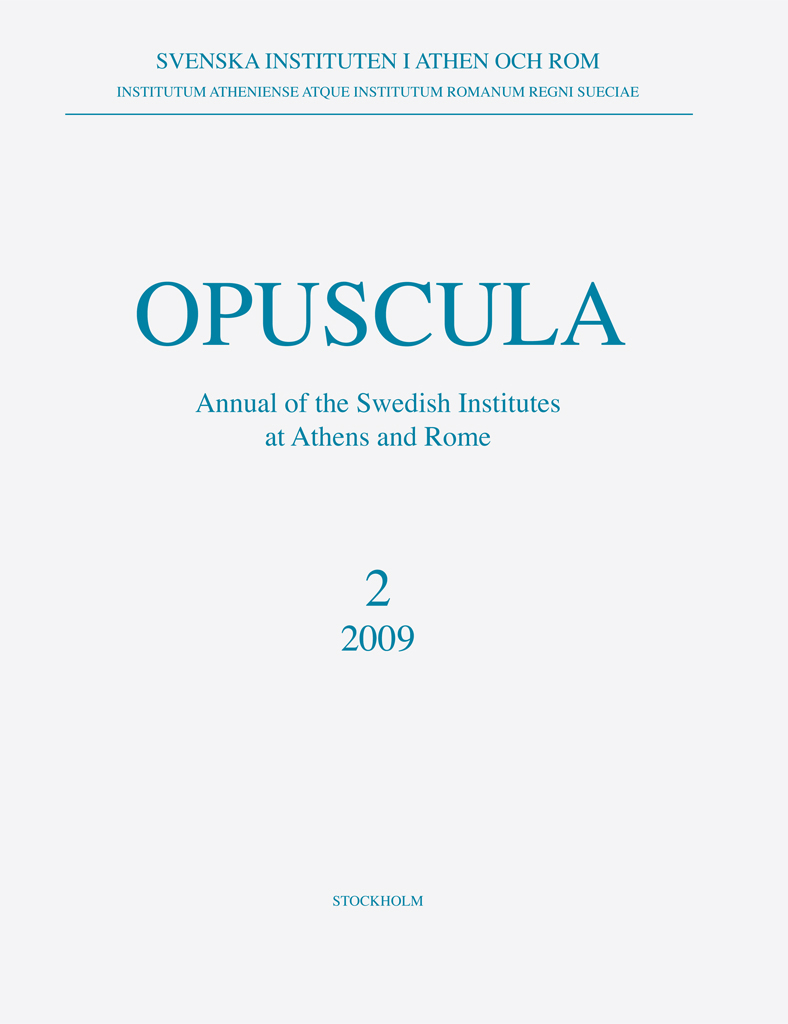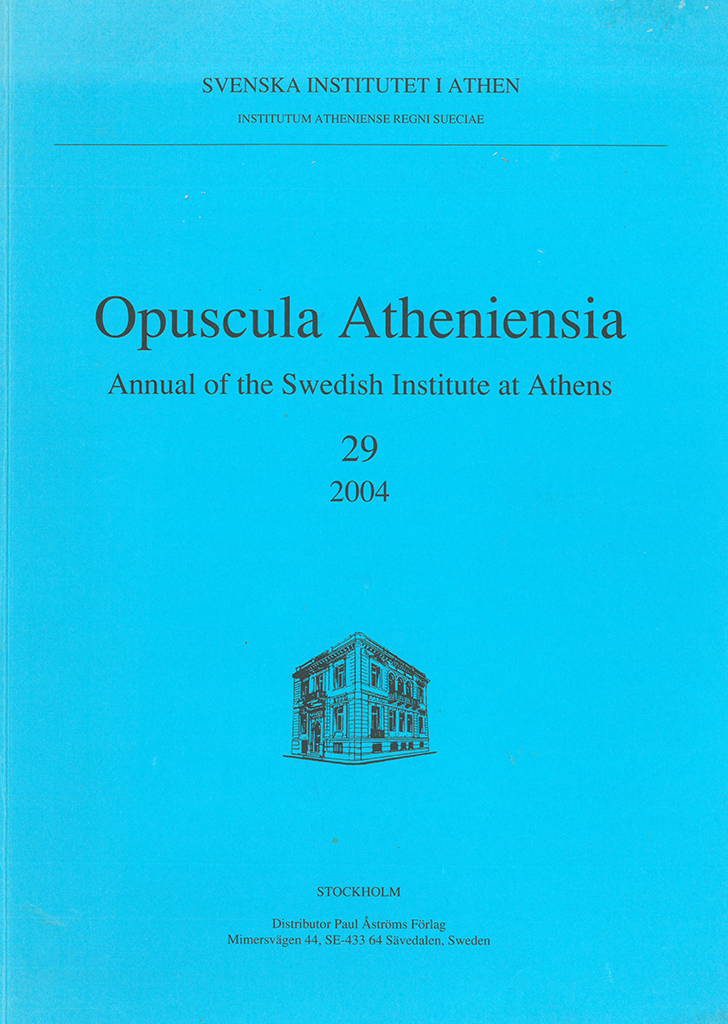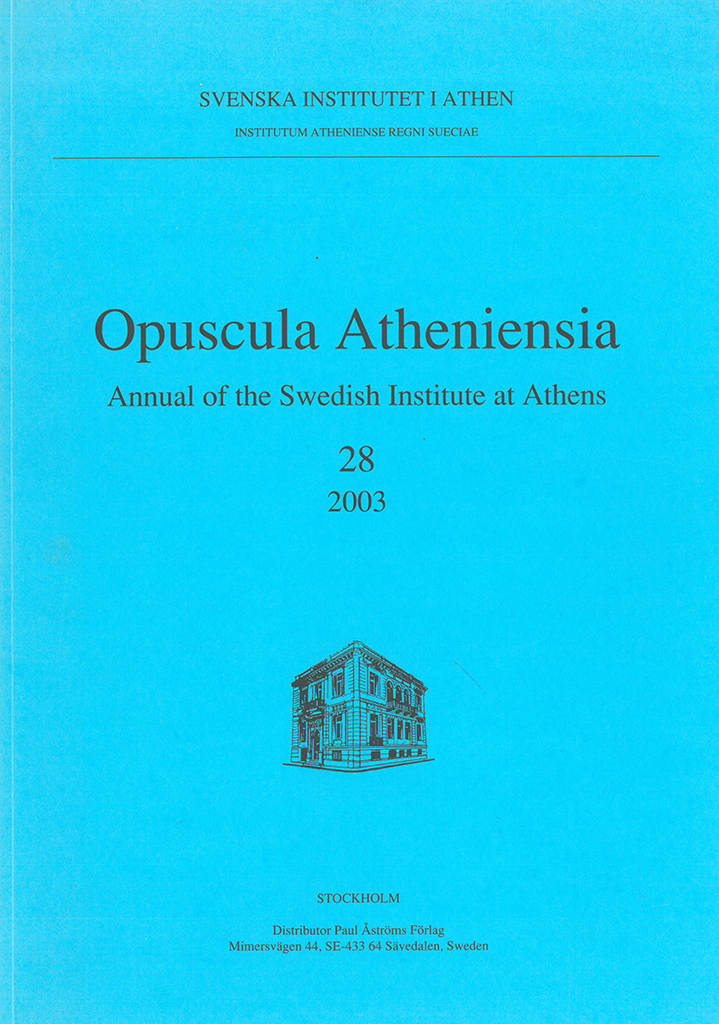Opuscula is published by the Swedish Institutes at Athens and Rome, with the aid of a grant from the Swedish Research Council. Distributed by Eddy.se AB. View journal at ERIH PLUS. All content available with open access. A Roman bath with broken windows in Asine, Argolis. The result of repeated earthquakes? By Dominic Ingemark (Uppsala University) Abstract A substantial assemblage of Roman window glass—consisting primarily of “cast”, matt/glossy examples, but also including cylinderblown, double-glossy window glass—was discovered during the 1926 excavations of a Late Roman bath in Asine, Argolis, the Peloponnese, Greece. It is clear that this material emanates from damage done to the building, and the question of whether this had human or natural causes is discussed in this paper: was it the “barbarian” invasion of the Visigoth king Alaric in the late 4th century AD that led to the windows being broken? Or, was the damage caused by the earthquakes known to have hit the Eastern Mediterranean area in Late Antiquity? Traces of destruction typical of earthquakes were found in the bath building, and the destruction occurred in a period known for its high seismic activity: the so-called Early Byzantine Tectonic Paroxysm, which led to the conclusion that the bath…
Opuscula is published by the Swedish Institutes at Athens and Rome, with the aid of a grant from the Swedish Research Council. Distributed by Eddy.se AB. View journal at ERIH PLUS. All content available with open access. Two Early Helladic II terracotta rollers from Asine and their glyptic context By Michael Lindblom (Uppsala University), Gullög Nordquist (Uppsala University) & Hans Mommsen (Universität Bonn). Abstract Two Early Helladic II terracotta rollers from the Third Terrace at Asine are presented. The objects, used to impress relief decoration on pithoi and hearths, are unique in that no other examples are known from the Early Bronze Age Aegean. Their origin is discussed based on chemical characterization and their depositional contexts are reviewed from an archaeological perspective. Although there are no known impressions from these rollers on pithoi and hearths at Asine, it is shown that their owners surrounded themselves with different objects featuring similar glyptic impressions. Two such impressions find identical parallels at Tiryns and the combined evidence strongly suggest that Asine was the home for one or several potters who produced Early Helladic impressed hearths and pithoi. Bibliographical information Michael Lindblom, Gullög Nordquist & Hans Mommsen, ’Two Early Helladic II terracotta rollers from…
Opuscula is published by the Swedish Institutes at Athens and Rome, with the aid of a grant from the Swedish Research Council. Distributed by Eddy.se AB. View journal at ERIH PLUS. All content available with open access. The last occupation of Asine in Argolis By Nektarios-Peter Yioutsos Abstract Kastraki Hill on the eastern Argolic Gulf, with visible remains of impressive fortifications, has been identified since the mid-19th century as the position occupied by the acropolis of ancient Asine. The first systematic excavations were carried out by the Swedish Institute in the 1920s and revealed the continuous habitation of the site from the Early Helladic period (3rd millennium BC) up to the late 4th-early 5th century AD. Many additions and repairs on the acropolis were made during the Byzantine period and the 2nd Venetian Occupation of the Peloponnese (1686–1715). However, the most destructive interventions in the area are the works carried out by the Italians during World War II. Fearing an invasion of the Allies on this side of the Peloponnese, the Italians fortified the acropolis by making additions to the ancient walls and constructing auxiliary buildings, pillboxes, observation posts and trenches around the rocky outcrop using materials from buildings of…
Opuscula is published by the Swedish Institutes at Athens and Rome, with the aid of a grant from the Swedish Research Council. Distributed by Eddy.se AB. View journal at ERIH PLUS. All content available with open access. Symbolic connotations of animals at early Middle Helladic Asine. A comparative study of the animal bones from the settlement and its graves By Stella Macheridis Abstract This paper is a contribution to the zooarchaeological research on animals or animal parts found in human graves during the Middle Bronze Age in Greece. The animal bones from the early Middle Helladic settlement (MH I-II, c. 2100–1800 BC) and contemporary burials at Asine are presented. The goal is to compare the animal bones from the settlement with those from the burials, in terms of species composition and body part distribution. Through this comparison, this paper aims to discuss any symbolic connotations of bone waste from everyday-life practices. The results show that the most common domesticates from settlement contexts, pig, sheep/goat and cattle, also appear to be the most abundant animals deposited in the early MH graves at Asine. This is consistent with mortuary data from other sites on the Peloponnese, especially Lerna. The pig was most…
Opuscula is published by the Swedish Institutes at Athens and Rome, with the aid of a grant from the Swedish Research Council. Distributed by Eddy.se AB. View journal at ERIH PLUS. All content available with open access. Home, refuse, and reuse during the Early Helladic III to the Middle Helladic I transitional period. A social zooarchaeological study of the Asine bothroi By Stella Macheridis Abstract The practice of digging, using, and filling large pits, cut into the ground and sometimes lined with clay, was extensive from the Early Helladic III to the Middle Helladic Period I (c. 2,200–1,900 BC) in large parts of the Aegean area. This particular type of feature is called bothros and has been reported since the early 20th century from many settlements, mainly from the Greek mainland. Although the bothroi are numerous in the archaeological record, few studies of them have been made. During the excavations at Asine, a prehistoric coastal settlement in the Argolid, a number of bothroi were identified. This paper is a contribution to the study of bothroi, and in particular of the faunal remains found within these features. I propose that the bothros was an important part of the domestic organization at…
Published by the Swedish Institute at Athens. Distributed by Eddy.se AB. Perspectives on ancient Greece. Papers in celebration of the 60th anniversary of the Swedish Institute at Athens Edited by Ann-Louise Schallin Abstract This volume presents current research related to Greek prehistory and Classical Archaeology and thus serves as a crosssection of the research strategies, which the Swedish Institute at Athens promotes. The topics relate to research, which span from the Neolithic to the Hellenistic times. The reason for putting this publication together is twofold: one aim is to publish the papers, which were put forward by a select number of Swedish scholars who were invited to give lectures at the Swedish Institute at Athens during the celebrations commemorating the Institute’s 60th anniversary on 10 May 2008. The second aim is to honour professor emeritus Robin Hägg, who was the director at the Swedish Institute at Athens from 1976 to 1994. This book thus consists of articles based on the lectures, which were held at the Swedish Institute celebrations on May 10 2008 and also of a number of articles by scholars who wished to celebrate Robin Hägg and who thus joined the venture. Contents Acknowledgements Ann-Louise Schallin | Introduction…
Opuscula is published by the Swedish Institutes at Athens and Rome, with the aid of a grant from the Swedish Research Council. Distributed by Eddy.se AB. View journal at ERIH PLUS. Content available with open access. Pictures and people. Seals, figurines and Peloponnesian imagery By Erika Weiberg Abstract The point of departure for this paper is the publication of two Early Helladic sealing fragments from the coastal settlement of Asine on the north-east Peloponnese in Greece. After an initial description and discussion they are set in the context of sealing custom established on the Greek mainland around 2500 BCE. In the first part of the paper focus is on the apparent qualitative differences between the available seals and the contemporary seal impressions, as well as between different sealing assemblages on northeastern Peloponnese. This geographical emphasis is carried into the second part of the paper which is a review and contextualisation of the representational art of the Aegean Early Bronze Age in general, and northeastern Peloponnese in particular. Seal motifs and figurines are the main media for Early Helladic representational art preserved until today, yet in many ways very dissimilar. These opposites are explored in order to begin to build a…
Opuscula is published by the Swedish Institutes at Athens and Rome, with the aid of a grant from the Swedish Research Council. Distributed by Eddy.se AB. View journal at ERIH PLUS. All content available with open access. Radiocarbon analysis and the history of the East Cemetary, Asine By Sofia Voutsaki, Søren Dietz & Albert J. Nijboer Abstract This paper presents the results of the radiocarbon analysis of human bones from the East Cemetery (IQ tumulus), Middle Helladic Asine. The analyses have been carried out at the Centre for Isotope Research, University of Groningen, using the AMS (Accelerator Mass Spectroscopy) method. The main aim of the analysis is to elucidate the history of use of the tumulus and the surrounding extramural cemetery by comparing the absolute dates with the relative dates based on the ceramic offerings and the internal stratigraphy of the tumulus. The establishment of a formal disposal area and the adoption of the tumulus are significant developments in the MH period, and it is therefore important to date their appearance with more precision. In addition, a more accurate reconstruction of the history of this important funerary monument gives us a better understanding of mortuary practices and social change in…
Published by the Swedish Institute at Athens. Distributed by Astrom Editions. Opuscula Atheniensia. Annual of the Swedish Institute at Athens 29, 2004 Contents Katie Demakopoulou, Nicoletta Divari-Valakou, Ann-Louise Schallin, Erika Weiberg, Lena Sjögren & Monica Nilsson | Excavations in Midea 2003 (pp. 9-27) Izabella Donkow | A Hellenistic wreathed male head from Cyprus in the Museum of Mediterranean and Near Eastern Antiquities in Stockholm (pp. 29-38) Niklas Hillbom | The Knossos game board (pp. 39-71) Isabelle Ratinaud-Lachkar | Insoumise Asiné? Pour une mise en perspective des sources littéraires et archéologiques relatives à la destruction d’Asiné par Argos en 715 avant notre ère (pp. 73-88) Book reviews Søren Dietz | M. Lindblom, Marks and makers. Appearance, distribution and function of Middle and Late Helladic manufacturers’ marks on Aeginetan pottery (pp. 89-90) Carl Nylander | J. Boardman, Persia and the West: an archaeological investigation of the genesis of Achaemenid art (pp. 90-92) Paavo Roos | P. Debord & E. Varinlioglu (eds.), Les hautes terres de Carie (pp. 92-94) Renée Forsell | S.E. Alcock, J.F. Cherry & J. Elsner (eds.), Pausanias. Travel and memory in Roman Greece (pp. 94-95) Jan Olof Rosenqvist | C. Mango (ed.), The Oxford History of Byzantium (pp. 95-97) Books received…
Published by the Swedish Institute at Athens. Distributed by Astrom Editions. Opuscula Atheniensia. Annual of the Swedish Institute at Athens 28, 2003 Contents Katie Demakopoulou, Nicoletta Divari-Valakou & Ann-Louise Schallin | Excavations in Midea 2002 (pp. 7-28) Berit Wells, Arto Penttinen & Marie Françoise Billot | Investigations in the sanctuary of Poseidon on Kalaureia 1997-2001 (pp. 29-87) Charles M. Adelman | The find group pottery from the Swedish excavations at Sina, Cyprus: significant sherds selected by Arne Furumark for his working notebook (pp. 89-171) Robert Parker | The problem of the Greek cult epithet (pp. 173-183) Birgitta L. Sjöberg | Settlement activity at Late Helladic Asine in the Argolid (pp. 185-201) Book reviews Lyvia Morgan | N. Marinatos, The Goddess and the Warrior. The naked goddess and Mistress of Animals in early Greek religion (pp. 203-204) Gunnel Ekroth | M. Deoudi, Heroenkulte in homerischer Zeit (pp. 204-207) Björn Forsén | Y.A. Pikoulas, Αρκαδια. Συλλογὴ μελετών (pp. 207-208) Björn Forsén | Y.A. Pikoulas, Λεξικό των οικισμών της Πελοποννήσου: παλαιά και νέα τοπωνύμια & F.A. Cooper (ed.), Houses of the Morea. Vernacular architecture of the northwest Peloponnesos (1205-1955) (pp. 209-210) Izabella Donkow | V. Tatton-Brown (ed.), Cyprus in the 19th century AD:…


